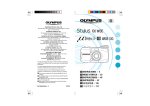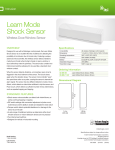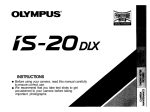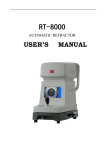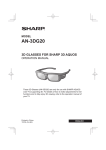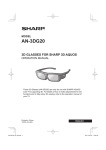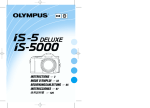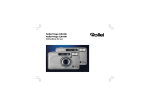Download Olympus AZ-220 Operating Instructions
Transcript
INSTRUCTIONS Before using your AZ-220 WIDE ZOOM, read this manual carefully to ensure correct use. We recommend that you take test shots to get accustomed to your AZ-220 WIDE ZOOM before taking important photographs. Thank you for purchasing the Olympus AZ-220 WIDE ZOOM. MAIN FEATURES Built-in 28mm~56mm 2X zoom lens: 28mm is perfect for scenery shots, while 56mm is ideal for quick snaps. Panorama* mode can be selected even in the middle of a loaded cartidge of film. Versatile, easy-to-use functions include continuous shooting, spot metering and various flash modes. *Be sure to read page 27 for Panorama-size prints. Symbols used in this manual: 2 Incorrect Manual operation Next operation Operation order Automatic operation Operation soun Indicator on Indicator blinking Attention Depress halfway PREPARATIONS Names and functions of parts....... Viewfinder display/LCD panel...... Diopter adjustment......................... Using the strap............................... Outline of operations..................... Loading the batteries.................... Checking the batteries.................. Points to remember....................... 10 12 13 14 BASIC OPERATIONS Loading the film ...................................................................................................... Taking pictures…………........................................................................................ Using the focus lock................................................................................................ Unloading the film ................................................................................................... 16 18 22 24 ADVANCED TECHNIQUES Taking Panorama pictures............ Flash photography......................... Using the SUBJECT button.......... Self-timer........................................ CAMERA MAINTENANCE Questions and answers................................................................................................... 38 Care and storage ............................................................................................................ 39 Battery handling............................................................................................................... 40 Troubleshooting............................................................................................................... 41 Specifications.................................................................................................................. 43 4 6 7 8 25 28 32 33 Continuous shooting...................... 34 Dual-frame self-timer..................... 35 Spot metering................................. 36 3 NAMES AND FUNCTIONS OF PARTS Power ON/OFF button PREPARATIONS Shutter release button LCD panel SUBJECT button Displays the camera's mode and operation conditions. (See p. 32.) (See p. 6.) FLASH button (See p. 14.) (See p. 28.) Self-timerindicator Flash Light sensor Autofocus windows Zoom buttons (See p. 19.) zooms in — telephoto. 4 Strap eyelet Lens zooms out — wide-angle. Viewfinder (See p.6.) PANORAMA selector (See p. 25.) Diopter adjustment Slide (See p. 7.) Strap eyelet Film window Back cover release Battery compartment cover Back cover Tripod socket Mid-roll rewind button 5 VIEWFINDER DISPLAY/LCD PANEL VIEWFINDER DISPLAY In Standard mode Orange lamp Close-up correction marks At a distance of 0.65 m (2.1 ft); your subject must be positioned within the close-up correction marks. In Panorama mode Close-up correction marks Lights when the flash will fire. Autofocus frame Position your subject within the autofocus frame. Green lamp Lights when the subject is in focus. LCD PANEL Flash modes (p. 28) 6 Self-timer (p. 34) Continuous mode (p. 34) Spot mode (p. 34) Dual frame self-timer mode (p. 35) Battery check (p. 13) Exposure counter (p. 17) Flash mode selection (p. 28) DIOPTER ADJUSTMENT TO ADJUST THE VIEWFINDER TO COMPENSATE FOR NEAR AND FARSIGHTED VISION. Slide the diopter adjustment slide until the viewfinder display becomes clear. Slide to the left if you are farsighted or to the right if you are nearsighted. 7 USING THE STRAP ATTACHING THE STRAP Strap-grip For a more comfortable, secure grasp of the camera, place the strap-grip as close to the camera as possible. 8 Strap-grip SOFT CASE (optional) When you aim the camera, hold the strap-grip as shown above. 9 OUTLINE OF OPERATIONS BASIC SHOOTING PROCEDURES 10 Load the batteries. (p. 12) Open the back cover.(p. 16) Load the film. (p. 16) Press the zoom buttons to make the subject larger or smaller. Place the autofocus frame on the subject you want to take a picture of. (p. 19) Depress the shutter release button halfway to make sure the green lamp lights. (p. 20) (p. 18) Close the back cover. (p. 17) Press the ON/OFF button to turn the power ON. (p. 18) Make sure the exposure counter on the LCD panel reads .(p. 17) Depress the shutter release button fully to take a picture. (p. 20) When the film reaches the end, it is automatically rewound. (p. 24) Open the back cover to remove the film. (p. 24) 11 LOADING THE BATTERIES Remove the battery 1. cover. the batteries and 2.Insert replace the battery cover. • Use two 3V lithium batteries (CR123A • Be sure the batteries are aligned or DL123A). 12 correctly as shown. Read "Battery handling" on page 40 . CHECKING THE BATTERIES the ON/OFF button 1. toPress turn the power ON. Be sure to check the batteries as well. Batteries are OK. The mark disappears after 12 sec. Batteries are low. Have spares handy. Batteries should be replaced immediately. 13 POINTS TO REMEMBER Hold the Camera Correctly. Correct. Correct. • Hold the camera firmly with both hands. • Hold the strap-grip as shown on page 9, • In the vertical position, hold the camera with 14 its flash positioned at the top. Incorrect. Caution; Keep your fingers away from the lens, flash, autofocus windows and light sensor. Proper Shutter Release. Practice before loading the film. Depress the Depress the 1. shutter release 2. shutter release button halfway button fully Cautions: • Press the shutter release button gently • Avoid shaking the camera when pressing the shutter button to prevent blurry pictures. To lock the focus. The green lamp lights in the viewfinder. To release the shutter and take the picture. 15 LOADING THE FILM BASIC OPERATIONS the back cover Insert the film cartridge, 1. Slide release upwards to open 2. making sure the film is the back cover. lying flat. Do not touch the inside of the camera, especially the lens. If the lens is dirty, use a blower brush to blow away the dust and lightly wipe off the lens with a soft cloth. 16 Correct Incorrect the film leader 3. Align with the red mark, and close the back cover. The film automatically advances to the first frame. the ON/OFF button 4. Press to turn the power ON. The exposure counter on the LCD panel reads Note: If blinks in the exposure counter, as shown above, reload the film. 17 TAKING PICTURES Press the ON/OFF 1. button to turn the power ON. the camera at your 2.Aim subject. Use the zoom buttons to make the subject larger or smaller. 18 The lens protector opens, the lens extends slightly, and the LCD panel activates. How to Use the Zoom Buttons Telephoto: Press the your subject 3. Position within the autofocus frame. © button to zoom in. Max. telephoto focal length: 56 mm Wide-angle: Press the button to zoom out. Max. wide-angle focal length: 28mm Autofocus frame 19 the shutter Depress the shutter 4.release release button fully. button halfway. 5.Depress The green lamp lights. 20 The film automatically advances to the next frame. Working Distance Close-Up Correction Picture frame Close-up correction marks The focus range of the camera is 0.65 m (2.1 ft) to (infinity). • When the subject is closer than 0.65 m (2.1 ft), the shutter will not release. (The green lamp blinks.) • When the subject is extremely close to the camera, the subject will be out of focus although the shutter releases. Image area of picture at 0.65m 2.1 ft The viewfinder's picture frame is the area that can be shot of subjects at (infinity). However, the picture area will move lower in the viewfinder as you get closer to the subject. At 0.65 m (2.1 ft), the shaded area is the actual available image area. In this case, the subject should be positioned below the closeup correction marks. 21 USING THE FOCUS LOCK TO AVOID TAKING OUT-OF-FOCUS PICTURES When the main subject is not in the center of the frame, use the focus lock. Position the autofocus frame on your subject and press the shutter release button halfway. 1. Autofocus frame 22 The autofocus frame must be positioned on the subject in order to focus on it. In the above case, the camera will focus on the tree in the background and the subjects will be out of focus. The green lamp lights. Reposition your subjects in Depress the shutter 2.keeping the picture frame while release button fully to 3. the shutter release take picture. button depressed halfway. Difficult Autofocus Subjects •Glossy and reflective surfaces • Black objects • Subjects behind glass or wire mesh • Flames and smoke • Excessively bright light within the picture area In the above situations, use the focus lock by focusing on a different subject at a similar distance. Then reposition the correct subject in the picture frame. 23 UNLOADING THE FILM 24 The camera automatically rewinds the film when you reach the end of a roll. Rewinding the film before the end of the roll After the motor stops and starts blinking on the LCD panel, open the back cover and remove the film. Press the mid-roll rewind button with the tip of a ballpoint pen, or the like. Do not use an instrument with a sharp tip. To select the Panorama mode: Slide the Panorama selector to the left. To select the Standard mode: Push upward the Panorama release. The Panorama selector slides back to the right. Viewfinder in the Panorama mode Viewfinder in the Standard mode ADVANCED TECHNIQUES TAKING PANORAMA PICTURES 25 CLOSE-UP PRINTING PANORAMA PICTURES CORRECTION IN THE PANORAMA MODE Close-up correction marks Picture frame Shot in the Standard mode Shot in the Panorama mode Film When printed Picture frame at 0.65 m As you approach the subject, the available image area reduces. At 0.65 m (2.1 ft), the subject must be positioned between close-up correction marks (the shaded area the in illustration) for satisfactory results. 26 Standard-size print Panorama print When Panorama pictures are shot, only the middle portion of the frame is exposed as shown. The number of exposures is the same as with the standard size. IMPORTANT INFORMATION REGARDING PANORAMA-FORMAT PRINTS There are three possible ways in which a roll of film may be taken: Shot only in the Standard mode Shot only in the Panorama mode Shot in both the Panorama and Standard modes With film taken as described in or , please be sure to inform your processing lab accordingly when you have your film developed. • When pictures taken in the Panorama mode are printed in the standard size, black strips appear at top and bottom of prints as shown on right. • Processing for may be more expensive and may take longer than that for . Ask the processing lab for more details. • Availability of Panorama format film processing facilities varies according to area. Consult your local film processor or camera dealer for details. 27 FLASH PHOTOGRAPHY This camera has five flash modes. Select the flash mode according to your shooting conditions and needs. How to select the flash mode: When the FLASH button is pressed, the flash mode changes in the order shown on the right. On the LCD panel, indicates the flash mode engaged. Mode Function Automatically fires in low-light and backlit conditions. (p. 29) Significantly reduces the phenomenon of "red-eye" (when a subject's eyes appear red). (p. 30) The flash does not fire. (p. 30) Fires regardless of available light. (p. 31) When you want to light the subject in the foreground with a night-scene in the background. (p. 31) 28 Note: AUTO-S will not be canceled when the power is turned OFF. All other modes will return to the AUTO mode. AUTO (Auto Flash Mode) In the Auto Flash mode, the flash will fire automatically in low-light and backlit conditions. Use this mode in ordinary situations. Flash Working Range ISO 0.65m~5.3m (2.1ft ~17.4ft) 0.65m~2.8m (2.1ft~9.2ft) 200 0.65m~7.5m (2.1ft~24.6ft) 0.65m~4.0m (2.1ft ~13.1ft) 400 0.65m~10.6m 0.65m~5.6m (2.1ft~18.4ft) 100 The orange lamp on the upper left of the viewfinder lights when the shutter release button is depressed halfway. WIDE (28mm) TELE (56mm) (2.1ft~34.8ft) Note: If a backlit subject is too small or is not centered in the frame, occassionally the flash may not fire automatically. If this occurs, use the FILL-IN mode. 29 AUTO-S (Red-Eye Reducing Flash) OFF (Flash Override) Significantly reduces the phenomenon of "red-eye" (when a subject's eyes appear red). When you don't want the flash to fire, even in the dark. In the Auto-S Flash mode, the camera will emit a series of low-power pre-flashes before the regular flash. This makes the subjects' pupils contract, significantly reducing red-eye. Except for the preflashes, this mode is the same as the Auto Flash mode. In the Flash-OFF mode, the flash does not fire even in low-light conditions. Use this mode in situations where flash photography is not desired or is prohibited. Note: Since a slow shutter speed (down to 2 seconds) is automatically selected in low-light IMPORTANT: Be sure to hold the camera still until 30 the shutter releases. situations, the use of a tripod is recommended to prevent blurred pictures caused by shaking the camera. FILL-IN (Forced Activation) Night-Scene Flash When you want to fire the flash every shot. When you want both the subject in the foreground and the night-scene in the background to be properly exposed. In the FILL-IN Flash mode, the flash fires regardless of available light. This mode can be used to brighten up a subject's shaded face, for example. Use the Night-Scene Flash mode to properly light the subject in the foreground while leaving the background naturally lit. Note: Since a slow shutter speed (down to 2 seconds) is automatically selected in low-light situations, the use of a tripod is recommended to prevent blurred pictures caused by shaking the camera. 31 USING THE SUBJECT BUTTON Press the SUBJECT button to select the required mode. Every time you press the SUBJECT button, the mode switches as shown below. Mode Function Normal Mode Self-Timer (p. 33) You can put yourself in the picture. 32 Continuous Shooting (p. 34) You can shoot a continuous series of pictures. Dual-Frame Self-Timer (p. 35) You can take two self-timer pictures in rapid succession. Spot Metering (p. 36) You can limit light metering to a particular area of the framed picture. Note: When the power is turned OFF and ON again, the camera returns to the Normal mode. SELF-TIMER To Put Yourself in the Picture 1. until Press the SUBJECT button is displayed on the LCD panel. at your subject, and press the shutter 2. Aim release button. Self-timer indicator lights. Blinks. The shutter will be released •The focus and exposure will be locked when the shutter release button is depressed halfway. seconds later. •After the shutter is released, the camera will return to the Normal mode. •To cancel the self-timer after it has been activated, press the SUBJECT button. Notes: 12 33 CONTINUOUS SHOOTING To Shoot a Continuous Series of Pictures. the SUBJECT 1. Press button until C is displayed on the LCD panel. Notes: 34 camera will shoot 2. The repeatedly as long as the shutter release button is fully depressed. • The shutter will release at intervals of 1.7 seconds (or 4 seconds after the flash fires). • The focus and exposure will be adjusted every frame. • If the subject gets closer than 0.65 m (2.1 ft), the shutter will automatically stop releasing. DUAL-FRAME SELF-TIMER To Take Two Self-Timer Pictures in Rapid Succession. Press the SUBJECT 1. displayed. button until is at your subject, and 2. Aim press the shutter release button. Notes: The shutter will be released for the first time in 12 seconds, and then for a second time 2 seconds later. • The interval between the first and second shutter release is approximately 2 seconds (or 5 seconds after the flash fires for the first shot). • After the shutter is released for the second shot. the camera will return to the Normal mode. 35 SPOT METERING To Limit Light Metering to a Particular Area of the Framed Picture. the SUBJECT 1.Press button until is displayed on the LCD the autofocus frame over the desired area. Depress 2. Position the shutter release button halfway to lock the exposure. panel. Note: 36 The focus will also lock when the shutter release button is depressed halfway. the shutter release button fully to take 3.Press pictures. 37 CAMERA MAINTENANCE QUESTIONS AND ANSWERS 38 Q: How long will the batteries last? A: If you use 24-exposure rolls of film and use the flash on half of all your pictures, two new 3V lithium batteries (DL123A/CR123A) will last for 30 or more rolls of film. If you do not use the flash and auto zoom very often, the batteries will last much longer. Q: How should I clean the lens? A: Wipe the lens gently with a soft, clean cotton cloth that has been moistened with a small amount of lens cleaning fluid. Q: Can I use film that is not DX-coded? A: Yes, but only ISO 100 film. Q: When does the camera measure and set the exposure? A: When the shutter release button is depressed halfway, the camera measures both the exposure and focus and locks them as long as the shutter release button remains halfway depressed. Q: I ran out of the stickers for the cartridge. Where can I get them? A: Ask your nearest Olympus service center. Q: Why doesn't the finished Panorama print show all the area that is shown on the Panorama picture negative? A: In a Panorama print, the center portion of the film, about 12 mm x 36 mm, is printed, however, to ensure optimal print size, the actually exposed area on the negative is made a little larger. Also, the area exposed on the negative may be smaller or larger depending on the zoom setting. Please note, however, that the Panorama picture seen in the viewfinder will be the actual Panorama picture when printed. (Refer to page 26 for close-up correction.) CARE AND STORAGE CAUTIONS • DO NOT EXPOSE THE CAMERA TO EXTREME HEAT (OVER 40°C/104°F) OR TO EXTREME COLD (BELOW -10°C/14°F). • AVOID SUDDEN TEMPERATURE CHANGES AND HUMIDITY. • DO NOT EXPOSE THE CAMERA TO STRONG MAGNETIC FIELDS. • DO NOT APPLY EXCESSIVE FORCE TO THE CAMERA OR ITS CONTROLS. • DO NOT TOUCH THE CONTACT POINTS INSIDE THE CAMERA. • DO NOT USE ORGANIC SOLVENTS, THINNERS, OR BENZINE TO CLEAN THE CAMERA. • AVOID STRONG IMPACTS CAUSED BY BUMPING OR DROPPING THE CAMERA. • DO NOT EXPOSE THE CAMERA TO WATER, SUCH AS FROM RAIN. • DO NOT EXPOSE THE CAMERA TO DUST AND SAND. WARNING • NEVER ATTEMPT TO DISASSEMBLE THE CAMERA; IT CONTAINS A HIGH-VOLTAGE CIRCUIT. In case of malfunction, consult your nearest Olympus dealer or Olympus service center. 39 BATTERY HANDLING NOTES • Even when batteries are brand-new, their service life may be shorter than specified if an extended period of time has passed since they were produced. • Do not mix different types of batteries or new and old batteries. • Keep spare batteries on hand when going on a long trip or to a cold area. • Sweat, oil, and so on can prevent a battery's terminals from making electrical contact. To avoid this, wipe both terminals before loading batteries. 40 WARNINGS • NEVER TRY TO DISASSEMBLE, RECHARGE, OR SHORT CIRCUIT BATTERIES. NEVER EXPOSE BATTERIES TO EXCESSIVE HEAT OR OPEN FLAMES. • KEEP THE BATTERIES OUT OF THE REACH OF CHILDREN. IF A CHILD SWALLOWS A BATTERY, CONTACT A DOCTOR IMMEDIATELY. • USE TWO 3V LITHIUM BATTERIES (CR123A OR DL123A). NEVER TRY TO DISASSEMBLE OR MODIFY ANY BATTERY OR BATTERY PACK FOR USE IN THIS CAMERA. TROUBLESHOOTING OPERATING PROBLEMS Symptom The camera does not work. Cause The power is OFF. The alignment of the battery The batteries are exhausted. The batteries are temporarily unable to function. Replace the batteries with new ones. p. 13 Keep the camera warm while using it. p. 40 The loaded film has been rewound. Load new film. Reload the film. p. 24 p. 17 The film is incorrectly loaded. The green lamp blinks, and the shutter will not See p. 18 p. 12 terminals is not correct. The LCD display turns off suddenly. Remedy Press the power button again. Reload the batteries correctly. The LCD display turns off after four and a half minutes if the camera is not used. Press the power button twice or the shutter release button halfway to turn on the LCD panel. In addition, the power is turned OFF The camera is closer than 0.65 m automatically after 4 hours. When the camera is not in use, keep the power OFF as much as possible. Move the camera farther than (2.1 ft) to the subject. 0.65 m (2.1 ft) from the subject. p. 21 release. The orange lamp blinks, The flash has not been recharged yet. The flash does not fire, even in the dark. Remove your finger from the shutter release button and wait for several and the shutter will not release. seconds until the flash is recharged The flash mode is set to OFF. before shooting. Set it to a mode other than OFF. p. 28 41 PROBLEMS WITH THE PRINTED PICTURES Symptom The picture is out of focus. The picture is too dark. Cause The camera moved when the shutter release button was pressed. The subject was not within the viewfinder's autofocus frame. The lens and autofocus windows were dirty. The autofocus window was blocked, such as by a finger. The subject was closer than the minimum working distance to the lens (0.65 m/2.1 ft). While using the self-timer, the shutter release button was pressed while standing right in front of the camera. The flash was blocked, such as by a finger. The subject was out of the working range of the flash. The flash mode was set to OFF. The subject was backlit. 42 Remedy Hold the camera correctly and press the shutter release button gently. Position the subject in the center of the See: p. 14 p. 22 frame, or use the focus lock. Clean the lens and autofocus windows. Hold the camera correctly, keeping your fingers clear of the autofocus windows. Shoot from more than 0.65 m (2. 1 ft) away from the subject. Do not stand in front of the camera. Press the shutter release button while looking through the viewfinder. Hold the camera correctly, keeping your fingers clear of the flash. Shoot within the flash working range. Check the flash mode before shooting. Set the flash mode to FILL-IN. p. 14 p. 21 p. 33 p. 14 p. 29 p. 28 p. 31 SPECIFICATIONS Type: Full automatic 35mm autofocus lens-shutter camera with built-in 28~56mm zoom lens. Film format: 35mm standard DX-coded film (24 X 36 mm, switchable to Panorama size). Lens: Olympus lens 28~56mm F3.5~6.5, 8 elements in 7 groups. Shutter: Programmed electronic shutter. Viewfinder: Panorama-standard switchable Kepler type zoom viewfinder (with autofocus frame, close-up correction marks, autofocus indicator and flash indicator). Diopter correction possible. Focusing: Active type autofocus system. Focus lock possible. Focusing range: 0.65 m (2.1 ft) - (infinity). Exposure control: Programmed automatic exposure control. Center-weighted average light metering, switchable to spot metering. Auto exposure range: Wide-angle — EV2.8 (F3.5, 2 sec.) to EV15 (F8.4, 1/500 sec.), Telephoto — EV4.4 (F6.5, 2 sec.) to EV17 (F15, 1/500 sec.). Exposure counter: Progressive type with automatic reset, displayed on LCD panel. Self-timer: Electronic self-timer 12-sec. delay. Dual-frame selftimer possible. Film speed range: Automatic setting with DX-coded film with Film rewind: Automatic film rewind (automatic rewind activation at end of film, automatic rewind stop). Rewind possible at any point with rewind button. Flash: Built-in flash. Recycling time: Approx. 0.2 ~ 3.5 sec. (at normal temperature with new batteries). Flash working range: Wide-angle — 0.65 ~ 5.3 m (2.1 ~17.4 ft), Telephoto — 0.65 - 2.8 m (2.1 - 9.2 ft) with ISO 100 color negative film; Wide-angle — 0.65 - 10.6 m (2.1 ~ 34.8 ft), Telephoto — 0 . 6 5 ~ 5 . 6 m (2.1 ~ 18.4 ft) with ISO 400 color negative film. Flash modes: AUTO (Automatic flash activation in low-light and backlight). AUTO-S (Red-eye reducing, in low-light and backlight). OFF (No flash). FILL-IN (Forced activation). 3 (For night scene with slowest shutter speed — 2 sec.). Battery check: Displayed on LCD panel. Power source: Two 3V lithium batteries (DL123A/CR123A). Dimensions: 136(W) X 73(H) X 56(D) mm (5-3/8 X 2-7/8 X 2-3/16 in) (without protrusions). Weight: 345 g (12.2 oz) (without batteries). ISO 50, 100, 200, 400, 800, 1600, 3200. For film with less than ISO 50, film speed is set to ISO 100. Film loading: Automatic loading. (Automatically advances to first frame when camera back is closed). Film advance: Automatic film winding. SPECIFICATIONS ARE SUBJECT TO CHANGE WITHOUT ANY OBLIGATION ON THE PART OF THE MANUFACTURER. 43 OLYMPUS OPTICAL CO., LTD. San-Ei Building, 22-2, Nishi Shinjuku 1 -chome, Shinjuku-ku, Tokyo, Japan. Tel. 03- 3340-2211 OLYMPUS CORPORATION Crossways Park, Woodbury, New York 11797-2087, U.S.A. Tel. 516-364-3000 OLYMPUS OPTICAL CO.(EUROPA)GMBH Postfach 104908, Wendenstrasse 14-16, 2000 Hamburg 1, Germany. Tel. 040-23773-0 OLYMPUS OPTICAL CO. (U.K.) LTD. 2-8 Honduras Street, London EC1Y OTX, United Kingdom. Tel. 071 2532772 PRINTED IN JAPAN 0192. 40MM












































